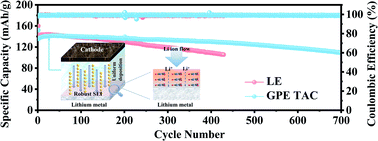In situ gelation regulating micro-electric fields to induce Li deposition in quasi-solid-state lithium metal batteries†
Abstract
Quasi-solid-state lithium metal batteries hold great potential for use in next generation energy systems due to their high energy capacity and safety. However, these systems still suffer from incompatible interphases and limited cycling performance due to Li dendrite growth. Considering this, nonpolar triallyl cyanurate with a ring-centred –C![[double bond, length as m-dash]](https://www.rsc.org/images/entities/char_e001.gif) N coupled structure with pentaerythritol tetraacrylate as a cross-linking agents was applied in the in situ synthesis of gel polymer electrolyte (GPE). The GPE displays high ionic conductivity (7.93 mS cm−1) at room temperature and high stability towards a Li metal anode. Furthermore, the micro-electric field created by triallyl cyanurate (TAC) after polymerization provides uniform adsorption sites for Li+ flow and induces even distribution, which ensures a long cycling life (700 cycles) with a capacity retention of 80.6% for a LiFePO4|GPE|Li battery at 1C. The design of the polymer skeleton provides new insights into solid-state battery optimization different from the intrinsic properties of the electrolyte. This polymeric electrolyte also allows for new opportunities to practically manufacture lithium metal batteries.
N coupled structure with pentaerythritol tetraacrylate as a cross-linking agents was applied in the in situ synthesis of gel polymer electrolyte (GPE). The GPE displays high ionic conductivity (7.93 mS cm−1) at room temperature and high stability towards a Li metal anode. Furthermore, the micro-electric field created by triallyl cyanurate (TAC) after polymerization provides uniform adsorption sites for Li+ flow and induces even distribution, which ensures a long cycling life (700 cycles) with a capacity retention of 80.6% for a LiFePO4|GPE|Li battery at 1C. The design of the polymer skeleton provides new insights into solid-state battery optimization different from the intrinsic properties of the electrolyte. This polymeric electrolyte also allows for new opportunities to practically manufacture lithium metal batteries.



 Please wait while we load your content...
Please wait while we load your content...